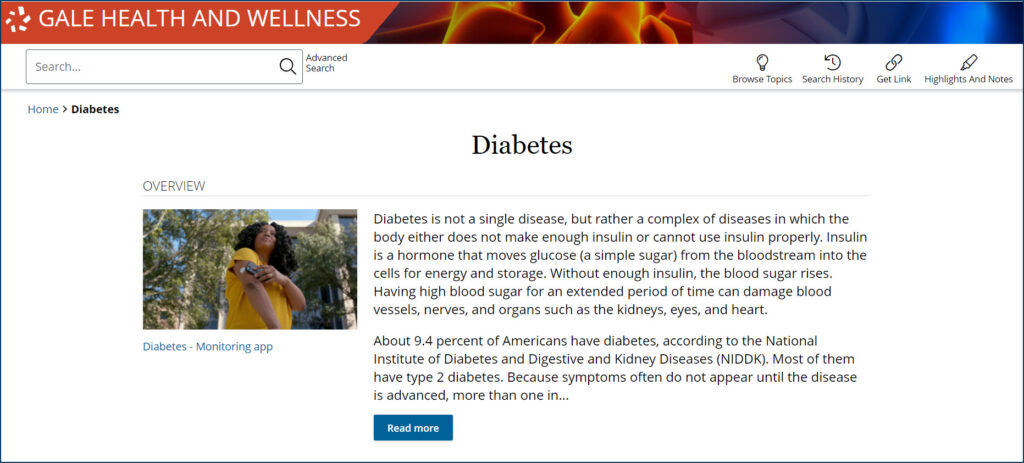According to the National Institute of Diabetes and Digestive and Kidney Diseases (NIDDK), more than 11% of Americans have diabetes. That’s more than 38 million people. Worldwide, diabetes affects more than 500 million adults.
Diabetes is a pervasive and complex disease, as there are different types and causes, and diabetes can be life-threatening if unmanaged. Related side effects are expansive and dangerous, including heart attack, kidney failure, blindness, nerve pain, and bacterial infections.
To help raise awareness for testing and treatment, the International Diabetes Foundation (IDF) and the World Health Organization (WHO) launched World Diabetes Day. Now officially recognized by the United Nations, people around the globe observe World Diabetes Day on November 14—a nod to the date in 1922 when researchers discovered insulin.
Whether in a public or academic space, your library can participate in World Diabetes Day to help raise awareness for your patrons. Rely on Gale Health and Wellness for accurate information related to diabetes’ causes, symptoms, and treatments. With our easy-to-navigate diabetes portal, you can share clear facts about the disease, debunk common myths, and encourage at-risk individuals to get tested.

Outline the General Facts
Diabetes does not always have apparent symptoms. Plus, there are different types, each with different causes and treatments. Use Gale Health and Wellness to develop and share a simple guide to the basics of diabetes:
- There are three distinct types of diabetes: Type 1 diabetes, Type 2 diabetes, and gestational diabetes. However, clinicians may further classify these categories for more accurate diagnoses (such as neonatal diabetes or Type 3c diabetes).
- All forms of diabetes relate to how the human body digests and uses glucose, a simple sugar molecule called a monosaccharide. When a person without diabetes eats carbohydrates (like pasta and potatoes), their digestive system breaks down those foods into sugars like glucose that the body uses for energy. People who have diabetes are not able to regulate their glucose levels, which causes severe damage to internal organs.
- The pancreas normally produces a vital hormone called insulin. Insulin helps our bodies use glucose effectively. Scientists can create lab-grown insulin that people with diabetes can inject as part of their treatment regimen.
As a librarian, you don’t need to dig too deep into the medical specifics, but you can compile a basic outline. Your library is a hub for trusted information and guidance for further research. Publicize the facts in your library space and direct patrons to Gale Health and Wellness for accessible and detailed diabetes-related content.
Eliminate Mistruths
Many people do not understand diabetes. A lack of knowledge about the disease can lead to shame and judgment, which may prevent individuals from sharing their experiences or seeking treatment.
For World Diabetes Day, tackle misinformation head-on. Using Gale Health and Wellness, debunk mistruths about diabetes and help eliminate prejudice around the disease. Here are some common misconceptions that you can help clarify:
- Because it is often diagnosed in children and adolescents, Type 1 diabetes is called juvenile diabetes. However, this condition can develop at any age.
- A diabetes diagnosis is not the patient’s fault. Genetics, race, and stress levels all factor into the risk for the disease.
- Overeating sugar does not cause diabetes. Excess sugar creates an unhealthy diet, which can heighten the risk, but it is not a cause-and-effect relationship.
- Insulin injections are a standard piece of diabetes treatment. While many adults are fearful of needles, these injections are painless and simple.
Share your myth-busting findings on social media and through other library outreach platforms, such as newsletters and displays. You might even create a true-or-false quiz to increase patron engagement.
Encourage Adults to Get Tested
NIDDK estimates that one in five Americans with diabetes do not know they have the disease. However, early interventions, like dietary changes and medication, can dramatically reduce the risk of diabetes or help alleviate dangerous side effects. To that end, rely on Gale Health and Wellness for information regarding the risk factors and warning signs to raise public awareness. Common risk factors include smoking, obesity, physical inactivity, hypertension, and high cholesterol.
Early diabetes symptoms aren’t super clear. Patients might experience fatigue, excessive thirst, frequent urination, or numbness in the hands or feet. Because diabetes is challenging to identify, medical experts recommend that everyone over 35 should receive a blood sugar screening every three years.
Unfortunately, diabetes testing requires a blood draw at a medical facility, which many people would rather avoid. Fear of needles, or trypanophobia, is very common; Gale Health and Wellness houses helpful context and guidance to help uneasy patrons overcome their anxieties.
Share Treatment Options
Ten percent of the world has diabetes, yet, unfortunately, shame is still all too common. As a trusted community partner, your library has a role to play. Through outreach and increased awareness, patrons will better understand that diabetes is both common and manageable.
Consider some creative ways to approach normalizing diabetes. For example, you might showcase celebrities who have the disease or invite a medical professional to speak at your library. You can also feature books that include characters with diabetes, and guide users to Gale Health and Wellness to research the latest innovations and normalize treatment options.
Diabetes treatment largely depends on the specific diagnosis and should always take place in consultation with medical professionals. However, there are a few consistent recommendations to share with your community and help normalize treatment:
- Glucose monitoring, which can be done at home, is very effective for prediabetic individuals or those with a confirmed diabetes diagnosis. Results can help patients better manage their disease through diet and medication.
- Insulin injections are the most common form of treatment for individuals with diabetes. Medical professionals will provide patients with a customized schedule for self-administration of insulin shots.
- Healthy eating is essential to preventing or managing diabetes. Avoid refined sugars and saturated fats in favor of nutritious foods like fruits, vegetables, whole grains, and low-fat proteins.
- Exercise helps reduce the risk of obesity and lowers blood sugar levels.
- Homeopathic treatments can also play a role in diabetes prevention and treatment of its symptoms. For example, chamomile reduces stress levels, and calendula can help treat skin ulcers. Plain yogurt can assist with digestive health and prevent yeast infections. Please note that while homeopathic treatments can be beneficial, remind patrons to speak with their clinicians first before turning to homeopathic remedies.

Diabetes care is evolving and improving. While there is no cure, through treatment and careful disease management, people can live long, healthy lives. For World Diabetes Day this November 14, share the facts, advocate for more accessible treatment options, and help destigmatize a disease that impacts hundreds of millions of people around the world. Get involved and leverage your library resources to improve diabetes awareness in your campus.
If your institution doesn’t subscribe to Gale Health and Wellness, you can contact your local rep today to learn more about our products.

